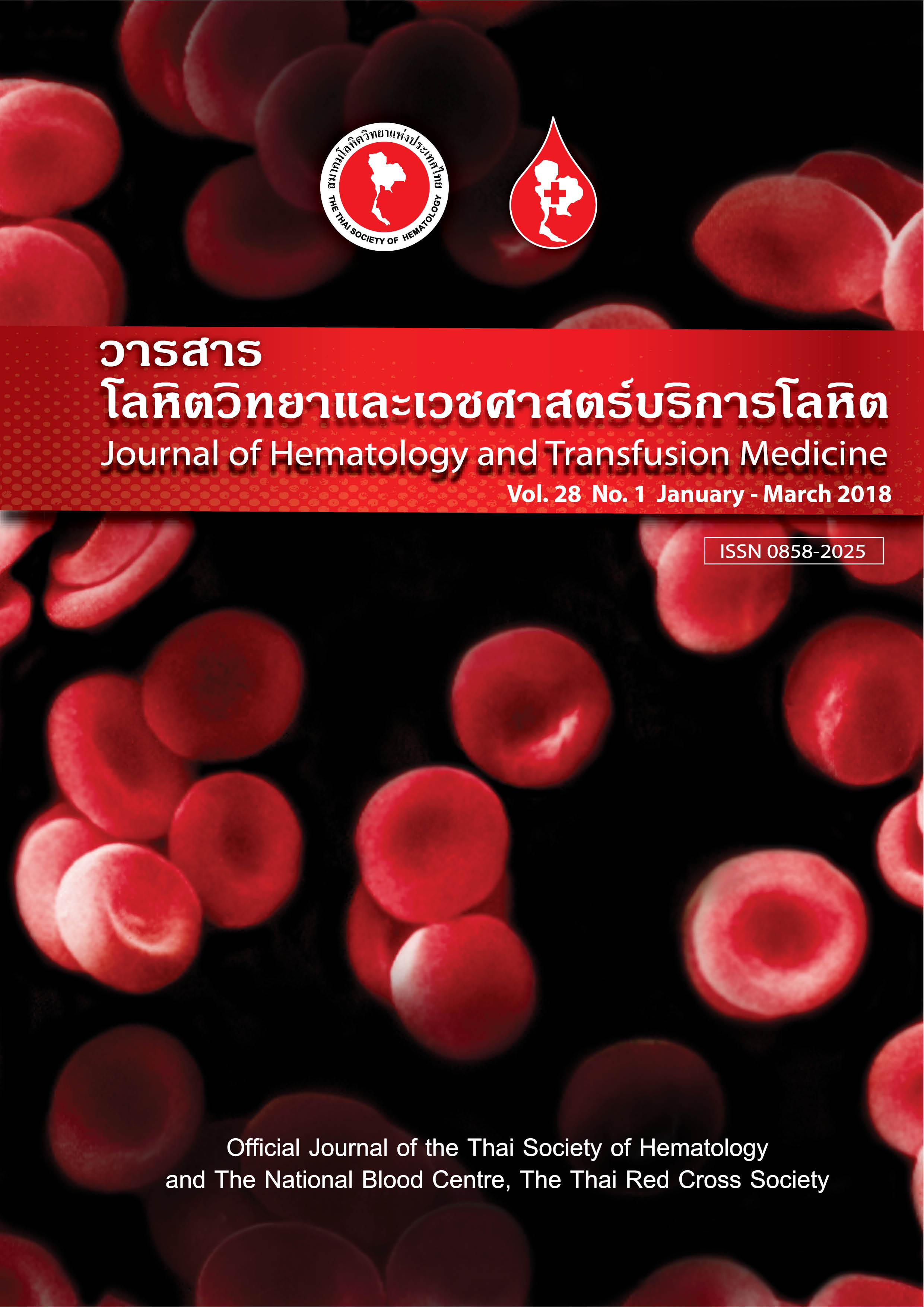Outcome of EPOCH Treatment in Newly Diagnosed Nodal Peripheral T-Cell Lymphomas at King Chulalongkorn Memorial Hospital
Keywords:
Nodal Peripheral T cell lymphoma, EPOCH regimen, Survival, ยาเคมีบำบัดสูตร EPOCH, ผลการรักษาAbstract
Title: Outcome of EPOCH Treatment in Newly Diagnosed Nodal Peripheral T-Cell Lymphomas at King Chulalongkorn Memorial Hospital
Objective: To evaluate the outcomes of patients with nodal PTCLs, who were treated with EPOCH regimen, and compare the results to those who received CHOP regimen.
Material and Methods: This was a Retrospective study between January 2005 and December 2015 at King Chulalongkorn Memorial Hospital. We enrolled patients aged more than 15 years with newly diagnosed nodal PTCLs as following: PTCL, NOS, ALK-negative anaplastic large cell lymphoma (ALCL) and angioimmunoblastic T-cell lymphoma (AITL) who received EPOCH or CHOP regimen.
Results: There were 34 patients with nodal PTCLs who met the inclusion criteria. Median age was 56 years (range, 36 to 83). The patients had PTCL, NOS (n=18, 53%), AITL (n=13, 38.2%) and ALK-negative ALCL (n=3, 8.8%). Eighty two percent of the patients were in stage III or IV. Fifteen patients were treated with EPOCH and 19 patients were treated with CHOP regimens. In EPOCH group, the overall response rate (CR+PR) was 83.3% with 66.7% having CR. The response rates of EPOCH in each subtype were PTCL, NOS (CR 60%, PR 20%), AITL (CR 60%, PR 20%), and ALK-negative ALCL (CR 100%). The baseline characteristics of the patients in EPOCH and CHOP groups were not statistically different. When compared between 2 groups, the response rates in nodal PTCLs treated with EPOCH were 83.3% (CR 66.7%, PR 16.6%), and in CHOP 70.6% (CR 47.1%, PR 23.5%) (p-value=0.66). The 5-year EFS in EPOCH compared with CHOP group were 44.2% and 24.9% (p-value=0.16), while the 5-year OS were 51.9% and 34.1%, respectively (p-value=0.69). Hematological toxicities (grade 3-4 neutropenia and febrile neutropenia) were not significantly different, however all patients in the EPOCH group received G-CSF prophylaxis.
Conclusions: EPOCH regimen is effective and well-tolerated. The response rate and survival seem to be better when compared to CHOP, although the difference was not statistically significant. Larger study is needed to elucidate the benefit of EPOCH regimen in nodal PTCLs.
ชื่อเรื่อง: ผลการรักษาของผู้ป่วย peripheral T cell lymphomas ที่ได้รับการรักษาด้วยยาเคมีบำบัดสูตร EPOCH ในโรงพยาบาลจุฬาลงกรณ์
วัตถุประสงค์: เพื่อศึกษาผลการรักษาของผู้ป่วย nodal peripheral T cell lymphomas (nodal PTCLs) ที่ได้รับยาเคมีบำบัดสูตร EPOCH และเปรียบเทียบกับผู้ป่วยที่ได้สูตร CHOP
วัสดุและวิธีการ: เป็นการศึกษาย้อนหลังในผู้ป่วยที่มีอายุมากกว่า 15 ปี เก็บข้อมูลผู้ป่วยใหม่ทุกรายที่ได้รับการวินิจฉัยเป็น nodal PTCLs ชนิดดังต่อไปนี้ Peripheral T cell lymphoma, not otherwise specified (PTCL, NOS), Anaplastic large cell lymphoma ชนิด ALK negative (ALK-negative ALCL) และ Angioimmunoblastic T cell lymphoma (AITL) และได้รับการรักษาด้วยยาเคมีบำบัดสูตร EPOCH หรือ CHOP ที่โรงพยาบาลจุฬาลงกรณ์ ตั้งแต่เดือนมกราคม พ.ศ. 2548 ถึงเดือนธันวาคม 2558
ผลการวิจัย: ผู้ป่วย 34 คน อายุเฉลี่ย 56 ปี (36-83 ปี) เป็นผู้ป่วย PTCL, NOS 18 คน AITL 13 คน และ ALK-negative ALCL 3 คน ผู้ป่วย 15 คน ได้รับการรักษาด้วยยาสูตร EPOCH และ 19 คน ได้รับสูตร CHOP กลุ่มที่ได้ EPOCH อัตราการตอบสนองใน PTCL, NOS เป็น complete response (CR) ร้อยละ 60, partial remission (PR) ร้อยละ 20, AITL ได้ CR ร้อยละ 60, PR ร้อยละ 20 และ ALK-negative ALCL ได้ CR ร้อยละ 100 เมื่อเปรียบเทียบกับการรักษาด้วย CHOP โดยลักษณะพื้นฐานของประชากรทั้งสองกลุ่มไม่มีความแตกต่างกันอย่างมีนัยสำคัญทางสถิติ พบว่าอัตราการตอบสนองต่อการรักษาในกลุ่ม EPOCH มีร้อยละ 83.3 (CR ร้อยละ 66.7 PR ร้อยละ 16.6) กลุ่ม CHOP มีร้อยละ 70.6 (CR ร้อยละ 47.1, PR ร้อยละ 23.5) (p-value=0.66) Event free survival (EFS) ที่ 5 ปี ในกลุ่ม EPOCH เป็นร้อยละ 44.2 และ CHOP ร้อยละ 24.9 (p-value=0.16), สำหรับอัตราการอยู่รอด (Overall survival, OS)ที่ 5 ปี คือ ร้อยละ 51.9 และร้อยละ 34.1 ตามลำดับ (p-value=0.69) ผลข้างเคียงทางระบบโลหิต (เม็ดเลือดขาวต่ำระดับ 3-4 และ Febrile neutropenia) ไม่มีความแตกต่างกันอย่างมีนัยสำคัญทางสถิติ อย่างไรก็ตามผู้ป่วยทุกคนในกลุ่ม EPOCH ได้รับ G-CSF prophylaxis
สรุป : ยาเคมีบำบัดสูตร EPOCH เป็นสูตรที่มีประสิทธิภาพ และผู้ป่วยสามารถทนต่อผลข้างเคียงได้ อัตราการตอบสนองต่อการรักษาและอัตราการรอดชีวิตมีแนวโน้มดีกว่าสูตร CHOP ถึงแม้ว่าจะไม่มีความแตกต่างกันอย่างมีนัยสำคัญทางสถิติ อย่างไรก็ตามต้องการการศึกษาในกลุ่มประชากรจำนวนมากขึ้นเพื่อยืนยันประสิทธิภาพของยาเคมีบำบัดสูตร EPOCH ต่อไป



